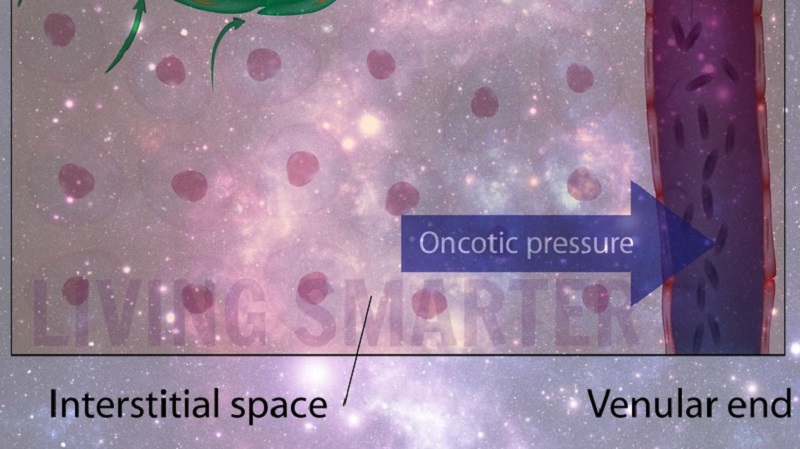The Interstitium, Interstitial Edema
and Fibromyalgia

You may have recently heard about this organ in the news called the Interstitium and you may wonder exactly what it is and what it does. You might also wonder how it relates to those of us with fibromyalgia. These are all excellent questions.
We must remember what I so often reiterate here, which is that Fibromyalgia is a multi-system condition. And, I believe that many of these systems work together.
So yes, I do believe that the Interstitial fluids do affect those of us with fibromyalgia and its primary co-conditions. First, I will explain what this organ is and then how it affects us with fibromyalgia.
What is the Interstitial Fluid?
The organ called the Interstitium is what houses the Interstitial fluid. This organ is neither inside or outside of the cell. This organ is actually its own network of fluid transporting vessels. This fluid contains elements such as salts, water, carbon dioxide, hormones, fatty acids, sugars, and oxygen.
It sounds similar to the things we see in the blood right ? Yes, and another interesting thing about this fluid is that there is over twice as much Interstitial Fluid in the body as there is blood. The human body carries about 5 liters of blood and about 11 liters of Interstitial Fluids.
You can see how this might be important to us right ? It is very important because of the propensity to retain fluids in the Interstitium just beneath the skin. Just like the skin (our largest organ), this Interstitium covers the entire body. It is basically just below the surface of the skin.
However, this is different from lymphedema, which I will explain more below.
The Interstitial Fluids of the Interstitium
and Fibromyalgia
Do you ever feel water retention that seems to occur over your entire body?
With fibromyalgia, you may not have this all of the time, but this feeling of water retention can come and go. Sometimes it can be influenced by stressors, both internally and externally. Physiological stress occurs more often in fibromyalgia due to its affect on various internal systems.
If your clothes tend to fit differently from one day to the next, or even one hour to the next, this can be an indicator of interstitial edema. If you tend to have more fluid (drinking) input during the day with less output (urine) during the day, but more fluid (urine) output in the morning after sleeping, this can be another indication of interstitial edema.
I talk about the importance of proper Hydration here and how we need to approach hydration effectively. You can read more there about “drying foods” and water intake and how this can create a vicious cycle.
Also, because fibromyalgia affects the soft tissue and edema causes swelling of the soft tissues, I do believe this creates another correlation. So now we may have the potential to have light swelling around the tender areas of the body, like the knees, neck, and the SI joints of the lower back.
Interstitial Edema vs. Lymphedema
Again, it is important to discern the difference between Interstitial Edema and Lymphedema. If you have fibromyalgia and other conditions or primary co-conditions, you need to be aware that abnormal swelling in any one part of the body needs to be addressed separately. That could be an indication of lymphedema. If you have had lymph nodes removed due to cancer surgery, then that would be another reason to watch for lymphedema.
Any major swelling in the legs or one part of the body needs to be addressed by a doctor, as this is likely to be more than interstitial edema.
Interstitial swelling of the Interstitium with fibromyalgia is more like when your rings fit a little more tightly, or your pants are uncomfortable, or maybe your face or hands feel a little swollen, but not major swelling in one part of the body. It does tend to affect quality of life though, and that is why we must address all possible contributors.
It bears noting here that traveling can cause issues with edema. If you have these issues during airplane travel or long car travels, you are not alone there.
Blood Vessels and Fibromyalgia
There is a certain amount of force on the body every day. Our heart uses force to pump blood through our blood vessels every day. Our lymphatic system needs additional force to pump lymphatic fluids. This can be why the blood vessels and capillaries are of great importance as well. In fact, you might remember our article on blood vessels and fibromyalgia.
What Can We Do About Interstitial Edema?
I believe that everything works together in the body. I also believe in everything we ascribe to in the website to treat you, the whole person living with a complex condition. One of our main goals is to help you prevent the worsening of fibromyalgia AND help to prevent any other condition down the road.
All of the tools we use and convey in the website will be helpful. Using the dietary principles I ascribe to, using safe and effective exercise, stress reduction (both internally and externally) and all of the other tools like compression (suitable for you) to increase blood flow and reduce retention.
Remember that “compression sleeves” for example, should not be medical grade unless you are dealing with lymphedema after a surgery. These can feel suffocating to people and I believe that is why people shy away, not getting the right compression for arms, legs, abdomen, etc. Experiment with different types of compression.
Avoid diuretics unless absolutely necessary. Go slow when detoxing with any type of sauna, even infra-red saunas. Sweating is great, but we want to be moderate with any "forced sweating" which can cause a rebound of water retention. Sweating during exercise is different and well advised. Again, my article listed above in this article on Proper Hydration is of great importance.
Read more below about what I like to call the "negative influencers" of Interstitial fluids.
Negative Influencers on the Interstitium, Its Interstitial Fluid and Suggestions
There are some things that can contribute to water retention in the interstitial spaces of the body.
* Medication (remember to always work with your doctor on medications you must take and work to take ONLY the lowest effective dose)
* Inactivity (safe and effective exercise is most helpful, follow on the Fibro Fit People page)
* Congested lymphatic system
* Hormonal imbalance
* Congested liver/bile
* Lack of restorative sleep (lack of restorative sleep deters the elimination systems from working properly, including the kidneys and lymphatic system)
* Consuming to many “drying” foods (read more here on Hydration)
* Trigger points around the body/fascia constriction
* Stress, high cortisol levels (adrenal stress)
Related Articles:
Before you leave, my sitemap can provide you with a "God's-eye" view of this website laid out in "outline format".
Stay connected by using the contact form below.
Home > Fibromyalgia Symptoms > The Interstitium, Interstitial Edema and Fibromyalgia
Didn't find what you were looking for? Search for it:
living-smarter-with-fibromyalgia.com
©2013-2025 All Rights Reserved
FibroFitPeople, LLC ;©2025 All Rights Reserved









